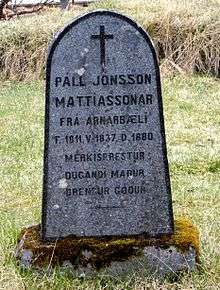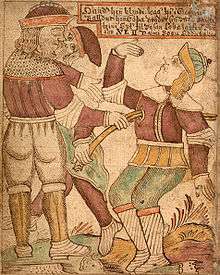Icelandic name

Icelandic names differ from most current Western family name systems by being patronymic or occasionally matronymic: they indicate the father (or mother) of the child and not the historic family lineage. Iceland shares a common cultural heritage with the Scandinavian countries of Norway, Sweden and Denmark with the Faroe Islands. Icelanders, however, unlike other Scandinavians, have continued to use their traditional name system, which was formerly used by all Nordic nations except partly Finland.[lower-alpha 1] The Icelandic system is thus not based on family names (although some people do have family names and might use both systems). Generally, a person's last name indicates the first name of their father (patronymic) or in some cases mother (matronymic).
Some family names do exist in Iceland, most commonly adaptations from last name patronyms Icelanders took up when living abroad, usually Denmark. Notable Icelanders who have an inherited family name include former prime minister Geir Haarde, football star Eiður Smári Guðjohnsen, actor Magnús Scheving, film director Baltasar Kormákur Samper, actress Anita Briem and member of parliament (and former news reporter) Elín Hirst. Before 1925, it was legal to adopt new family names; one Icelander to do so was the Nobel Prize-winning author Halldór Laxness, while another author, Einar Hjörleifsson and his brothers all chose the family name "Kvaran". Since 1925, one cannot adopt a family name unless one explicitly has a legal right to do so through inheritance.[2] (The law was amended in 1991 and 1996.[3])
First names not previously used in Iceland must be approved by the Icelandic Naming Committee (Icelandic: Mannanafnanefnd) before being used.[4] The criterion for acceptance of names is whether or not they can be easily incorporated into the Icelandic language. With some exceptions, they must contain only letters found in the Icelandic alphabet (including þ and ð), and it must be possible to decline the name according to the language's grammatical case system, which in practice means that a genitive form can be constructed in accordance with Icelandic rules.
Gender-inappropriate names are normally not allowed; however, in January 2013, a 15-year-old girl named Blær (a masculine noun in Icelandic) was allowed to keep this name in a court decision that overruled an initial rejection by the naming committee.[5] Her mother Björk Eiðsdóttir did not realize at the time that Blær was considered masculine; she had read a novel by Halldór Laxness, The Fish Can Sing (1957), that had an admirable female character named Blær, meaning "light breeze", and had decided that if she had a daughter, she would name her Blær.[6]
Typical Icelandic naming

A man named Jón Einarsson has a son named Ólafur. Ólafur’s last name will not be Einarsson like his father’s; it will become Jónsson, literally indicating that Ólafur is the son of Jón (Jóns + son). The same practice is used for daughters. Jón Einarsson's daughter Sigríður’s last name would not be Einarsson but Jónsdóttir. Again, the name literally means "Jón’s daughter" (Jóns + dóttir).
In some cases, an individual’s surname is derived from a parent's middle name instead of the first name. For example, if Jón is the son of Hjálmar Arnar Vilhjálmsson he may either be named Jón Hjálmarsson (Jón, son of Hjálmar) or Jón Arnarsson (Jón, son of Arnar). The reason for this may be that the parent prefers to be called by the middle name instead of the first name; this is fairly common. It may also be that the parent’s middle name seems to fit the child’s first name better.
In cases where two people in the same social circle bear the same first name and the same father’s name, they have traditionally been distinguished by their paternal grandfather’s name, e.g. Jón Þórsson Bjarnarsonar (Jón, son of Þór, son of Bjarni) and Jón Þórsson Hallssonar (Jón, son of Þór, son of Hallur). This practice has now become less common (the use of middle names having replaced it), but features conspicuously in the Icelandic sagas.
Matronymic naming as a choice
The vast majority of Icelandic last names carry the name of the father, but occasionally the mother's name is used: e.g. if the child or mother wishes to end social ties with the father. Some women use it as a social statement while others simply choose it as a matter of style.
In all of these cases, the convention is the same: Ólafur, the son of Bryndís, will have the full name of Ólafur Bryndísarson ("the son of Bryndís"). One well-known Icelander with a matronymic name is football player Heiðar Helguson ("Helga's son"), another is novelist Guðrún Eva Mínervudóttir ("Minerva's daughter"). One medieval example is the poet Eilífr Goðrúnarson ("Goðrún's son").
In the Icelandic film Bjarnfreðarson the title character's name is the subject of some mockery for his having a woman's name – as Bjarnfreður's son – not his father's. In the film this is connected to her radical feminism and shame over his paternity, which form part of the film's plot.[7] Some people have both a matronymic and a patronymic: for example, Dagur Bergþóruson Eggertsson ("the son of Bergþóra and Eggert"), the current mayor of Reykjavík. Same with the girl Blær above, who won the right to use this name—her full name is Blær Bjarkardóttir Rúnarsdóttir (Blær, Björk's and Rúnar's daughter).
Cultural ramifications – how to address people
In Iceland, listings such as the telephone directory are alphabetised by first name rather than surname. To reduce ambiguity, the telephone directory goes further by also listing professions. In Russia, where name-patronyms of similar style were historically used (such as Ivan Petrovich), the much larger population necessitated the introduction of surnames, and delegated the patronymic to record-keeping middle-name and conversational honorific.
Icelanders formally address others by their first names. By way of example, the former prime minister Jóhanna Sigurðardóttir would not be introduced as 'Ms Sigurðardóttir' but either by her first name or her full name, and usually addressed by her first name only.
In the case of two people in the same group having the same given name, perhaps one named Jón Stefánsson and the other Jón Þorláksson, one could address Jón Stefánsson as "Jón Stefáns" and Jón Þorláksson as "Jón Þorláks". When someone holds a conversation with these two people at the same time, the appendage "son" would not need to be used; in that case, the genitive form of the father's name could be used like a nickname, although it is just as common in such cases to refer to people by their middle names (having a middle name being nowadays the general rule for people with a common name like 'Jón').
While the name of Icelandic singer Björk is generally perceived as her stage name, it is actually simply her first name (her full name is Björk Guðmundsdóttir). Björk is how any Icelander would address her, whether formally or casually.
As a result of the vast majority of people using patronymics, a family will normally have a variety of last names: the children of (married or unmarried) parents Jón Einarsson and Bryndís Atladóttir could be named Ólafur Jónsson and Katrín Jónsdóttir. With matronymics, the children in this example would be Ólafur Bryndísarson and Katrín Bryndísardóttir. Patronymics thus have the formula (genitive case of father's name, usually adding -s, or if the name ends in -i, it will change to -a) + son/dóttir, whereas matronymics are (genitive case of mother's name, often -ar, or if the name ends in -a, it will change to -u) + son/dóttir.
The Icelandic naming system occasionally causes problems for families travelling abroad, especially with young children, since non-Icelandic immigration staff (apart from those of other Nordic countries) are usually unfamiliar with the practice and therefore expect children to have the last names of their parents.
However, people of Icelandic descent who live in foreign countries, such as the significant Icelandic community in the Canadian province of Manitoba, usually abandon the traditional Icelandic naming system. In most cases, they adapt to the naming conventions of their country of residence—most commonly by retaining the patronymic of their first ancestor to immigrate to the new country as a permanent family surname, much as other Scandinavian immigrants did before surnames became fully established in their own countries.[8] Alternatively, a permanent family surname may sometimes be chosen to represent the family's geographic rather than patronymic roots; for example, Canadian musician Lindy Vopnfjörð's grandfather immigrated to Canada from the Icelandic village of Vopnafjörður.[9]
See also
- List of Icelanders
- Icelandic language
- Scandinavian family name etymology
- Germanic name
- Naming conventions that share similarities with Icelandic names: Ethiopian name, Mongolian name, Russian patronymics, Scottish Gaelic personal naming system, Malay name
Notes
References
- ↑ "Surnames with the suffix -son or -dotter". Swedish Patent and Registration Office. Retrieved 25 October 2013.
- ↑ "Personal Names Act". Ministry of the Interior. Retrieved 25 October 2013.
- ↑ http://grapevine.is/mag/column-opinion/2014/07/10/so-whats-this-naming-law-i-keep-hearing-about/
- ↑ "Naming Committee accepts Asía, rejects Magnus". Iceland Review Online. Retrieved 12 September 2006.
- ↑ Blaer Bjarkardottir, Icelandic Teen, Wins Right To Use Her Given Name, Huffington Post, 31 January 2013
- ↑ Where Everybody Knows Your Name, Because It’s Illegal, The Stateless Man, January 28, 2013], Huffington Post, 31 January 2013
- ↑ TheLurkingFox (26 December 2009). "Mr. Bjarnfreðarson (2009)". IMDb. Retrieved 31 December 2014.
- ↑ "Icelandic anchor makes Manitoba connection". Winnipeg Free Press, 26 July 2008.
- ↑ "Where Are They Now?" Lögberg-Heimskringla, February 24, 1995.
External links
- Information on Icelandic Surnames (Ministry of the Interior)
- English translation of the Personal Names Act No. 45 of 17 May 1996 (Ministry of the Interior)
- Helgason, Gudjon (31 January 2013). "Icelandic Girl Wins Right to Use Her Given Name". U.S. News and World Reports. Associated Press.
